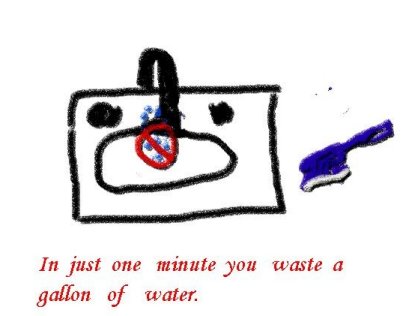|
Ms. Pierce |
|
I presented the Beautiful Spring,
Beautiful Earth project to Mrs. Brock’s 3rd Grade class as a
possibility for our next project during their weekly computer lab
time. They decided to work in collaborative groups. After the class
divided into groups, they selected an informational text (nonfiction
book) to use as research material for their project. They had
several options for their final product. The groups, books, and
products are listed below, we hope you enjoy them.
Hannah, Kylee, Gabriele, and Tevra
decided to create an Earth Day poster for display in our school.
They read the book EVERY DROP COUNTS a book about water
by Jill Wheeler. They used Kid Pix Deluxe 3 to create their
artwork and some of their text. They also used Word Art in
Microsoft Word for their title. After they created their poster,
they used the digital camera to take a photo to share their poster
with you.

Here is their artwork up close so you
can read it better.
Erin, Carli, and Baylee decided to
create an illustration with graphic software to participate in the
Earth Day Groceries project. They used Kid Pix Deluxe 3 to
create their graphic and then they exported it into Microsoft
Word. The book they read was Read About Pollution by
Herta S. Breiter.
Taylor decided to create stationery for students to use to write stories or poetry on. Instead of using a digital camera to produce her graphic, she decided to use Kid Pix Deluxe 3. Then her graphic was exported to Microsoft Word and the watermark stationery was created. Taylor read Global Change by Theodore P. Snow. Please feel free to print her stationery and use it in your writing centers.
Austin and Zane decided to write an acrostic poem. Using Internet Explorer and the web site listed below they created their acrostic poem. This web site takes you through the steps of brainstorming words or ideas and then automatically makes an acrostic poem. Click on this link to create your own acrostic poem. After their poem was created it was copied and pasted into Microsoft Word to share with you. Austin and Zane also used Global Change by Theodore P. Snow for their research.
Malcolm, John, and Nate are great artists and decided to illustrate the beginning, middle, and end of a book. They looked through several books and did not find one they liked so they decided to write their own book and illustrate it. They used Microsoft Word to write their book, Internet Explorer, and Microsoft Paint to create their graphics. The book they wrote is Recycling by John, Nate, and Malcolm.
Aaron, Colton , and Kyler decided to show recycling. Colton used his digital camera at home and traveled around the city taking pictures of recycling. They decided they needed to write something about recycling to go along with their pictures and graph. They used Microsoft Word, Microsoft Excel, and a digital camera to create their part of the project. The book they used was Recycle That! by Fay Robinson
National Technology Standards
SOCIAL, ETHICAL AND HUMAN ISSUES
Students develop positive attitudes toward technology uses that support lifelong learning, collaboration, personal pursuits, and productivity TECHNOLOGY PRODUCTIVITY TOOLS Students use technology tools to
enhance learning, increase productivity, and promote creativity. BASIC OPERATIONS AND CONCEPTS Students demonstrate a sound
understanding of the nature and operation of technology systems. National Language Arts Standards PARTICIPATING IN SOCIETY Students participate as knowledgeable, reflective, creative, and critical members of a variety of literacy communities. APPLYING LANGUAGE SKILLS Students use spoken, written, and visual language to accomplish their own purposes (e.g., for learning, enjoyment, persuasion, and the exchange of information). COMMUNICATION SKILLS Students adjust their use of spoken, written, and visual language (e.g., conventions, style, vocabulary) to communicate effectively with a variety of audiences and for different purposes. National Science Standards PERSONAL AND SOCIAL PERSPECTIVES As a result of activities in grades K-4, all students should develop understanding of Personal health National Social Studies Standards ROLES OF THE CITIZEN What are the Roles of the Citizen in
American Democracy? |

© Susan Silverman & Linda
Brandon - Beautiful Spring, Beautiful Earth 2005









